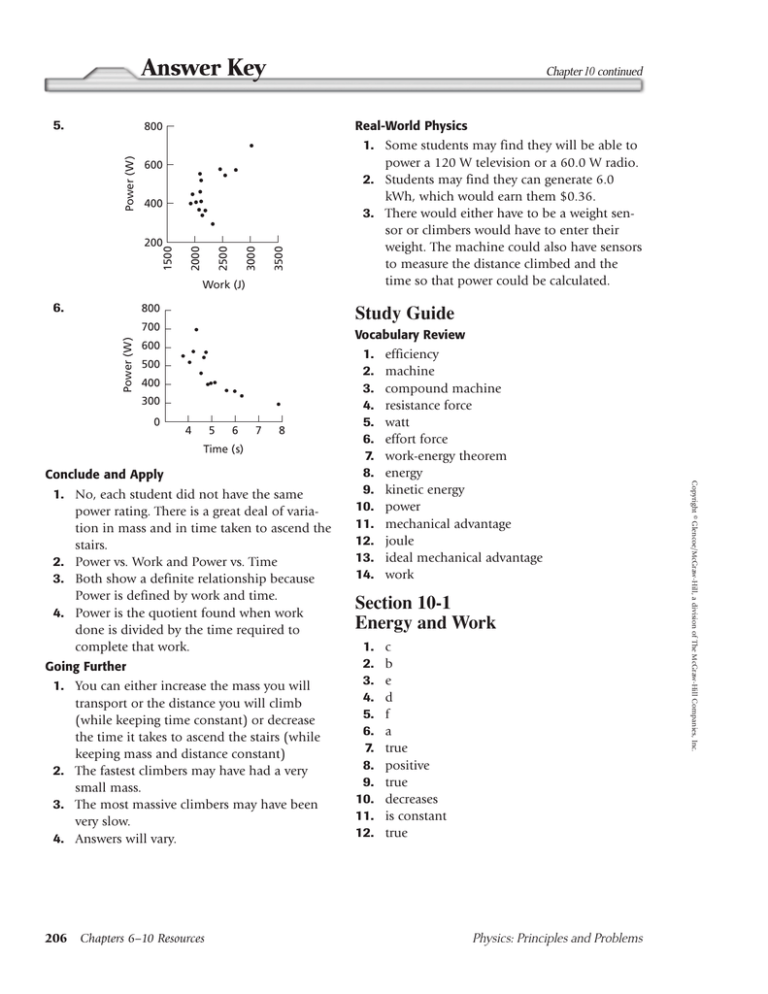Glencoe Chapter 10 Study Guide Answers
advertisement

Answer Key 5. Chapter 10 continued Real-World Physics 600 3500 3000 2500 200 2000 400 1500 Power (W) 800 Work (J) 6. 800 Study Guide Power (W) 700 Vocabulary Review 600 500 400 300 0 1. Some students may find they will be able to power a 120 W television or a 60.0 W radio. 2. Students may find they can generate 6.0 kWh, which would earn them $0.36. 3. There would either have to be a weight sensor or climbers would have to enter their weight. The machine could also have sensors to measure the distance climbed and the time so that power could be calculated. 4 5 6 7 8 Time (s) 1. No, each student did not have the same power rating. There is a great deal of variation in mass and in time taken to ascend the stairs. 2. Power vs. Work and Power vs. Time 3. Both show a definite relationship because Power is defined by work and time. 4. Power is the quotient found when work done is divided by the time required to complete that work. Going Further 1. You can either increase the mass you will transport or the distance you will climb (while keeping time constant) or decrease the time it takes to ascend the stairs (while keeping mass and distance constant) 2. The fastest climbers may have had a very small mass. 3. The most massive climbers may have been very slow. 4. Answers will vary. 206 Chapters 6–10 Resources efficiency machine compound machine resistance force watt effort force work-energy theorem energy kinetic energy power mechanical advantage joule ideal mechanical advantage work Section 10-1 Energy and Work 1. 2. 3. 4. 5. 6. 7. 8. 9. 10. 11. 12. c b e d f a true positive true decreases is constant true Physics: Principles and Problems Copyright © Glencoe/McGraw-Hill, a division of The McGraw-Hill Companies, Inc. Conclude and Apply 1. 2. 3. 4. 5. 6. 7. 8. 9. 10. 11. 12. 13. 14. Answer Key Chapter 10 continued 13. W . 0 → Copyright © Glencoe/McGraw-Hill, a division of The McGraw-Hill Companies, Inc. d→ 14. W 5 0 ↑ or ↓ d→ 15. W , 0 ← d→ 16. 0.50 m 17. 30.0 N 18. The area represents the work done on the crate. 19. W 5 Fd 5 (30.0 N)(0.10 m) 5 3.0 J 20. From 0.0 m to 0.40 m, the area under the graph is A 5 lw 5 (0.40 m)(30.0 N) 5 12 J. Using the equation for work, W 5 Fd 5 (30.0 N)(0.40 m) 5 12 J. The answers are the same. 21. First, find the area under the graph from 0.50 m to 0.70 m, consisting of a rectangle and a triangle on top of it formed by the sloped line. Arectangle2 5 (30.0 N)(0.20 m) 5 6.0 J 1 Atriangle 5 }} (0.20 m)(10.0 N) 5 1.0 J 2 Add to this the area under the graph from 0.0 m to 0.50 m. Arectangle1 5 (30.0 N)(0.50 m) 5 15 J The total work is equal to the total area under the graph: Atotal 5 Arectangle1 1 Arectangle2 1 Atriangle 5 15 J 1 6.0 J 1 1.0 J 5 22 J 22. d 23. b 24. c 25. e 26. a Section 10-2 Machines 1. 2. 3. 4. 5. simple and complex either the direction or the magnitude true cannot resistance Physics: Principles and Problems 6. 7. 8. 9. 10. 11. 12. 13. 14. 15. 16. 17. 18. 19. 20. 21. 22. 23. 24. 25. 26. ratio true can true equal to ideal machine true equal to greater c d d b b b b d d a c a. Wi 5 Wo Fidi 5 Fodo (218 N)di 5 (1050 N)(0.110 m) (1050 N)(0.110 m) di 5 }}} 5 0.530 m 218 N b. (0.783)Wi 5 Wo (0.783)Fidi 5 Fodo (0.783)(218 N)di 5 (1050 N)(0.110 m) (1050 N)(0.110 m) di 5 }}} 5 0.677 m (218 N)(0.783) 10-1 Section Quiz 1. The work-energy theorem states that when work is done on an object, the result is a change in kinetic energy. It can be represented by the equation W 5 ∆KE. 2. W 5 Fd 5 (328 N)(3.55 m) 5 1160 J 3. W 5 Fd cos u 5 (485 N)(2.66 m)(cos 15.0°) 5 1250 J Chapters 6–10 Resources 207

